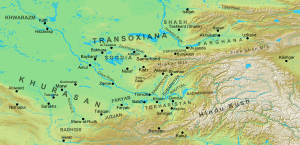Khurasan Road
The (Great) Khurasan Road was the great
It is very well-documented in the Abbasid period, when it connected the core of the capital city of Baghdad with the northeastern province of Khurasan.
History
Archaeological findings suggest the road was in regular use in the 3rd millennium BC, connecting Central Asia with Mesopotamia.[1] During the Achaemenid period, the road constituted the eastern segment of the Royal Road system.[2]
Course
The Achaemenid road began from the
connected Bactra to the Indus Valley.The Khurasan Road is possibly the best documented of the roads of the Abbasid realm;

The first settlement after Baghdad was Nahrawan or Jisr Nahrawan ("Bridge of Nahrawan"), named after the great

After entering Khurasan, the road divided in two: a northern branch, also called the "
See also
- Great Trunk Road
- Royal Road
- Silk Road
References
- ISBN 978-2-35668-177-5.
- ^ a b Briant 2002, p. 358.
- ISBN 978-0-939214-66-2.
- ^ Le Strange 1905, p. 9.
- ^ Le Strange 1905, pp. 12, 85.
- ^ Le Strange 1905, p. 31.
- ^ Le Strange 1905, pp. 59–61.
- ^ Le Strange 1905, pp. 62–63.
- ^ Le Strange 1905, pp. 63, 191.
- ^ Le Strange 1905, pp. 191–192.
- ^ Le Strange 1905, p. 228.
- ^ Le Strange 1905, pp. 364, 367–368.
- ^ Le Strange 1905, p. 430.
- ^ Le Strange 1905, pp. 430–431.
- ^ Le Strange 1905, pp. 430–431, 472.
- ^ Le Strange 1905, p. 472.
- ^ Le Strange 1905, pp. 475, 488.
Sources
- ISBN 978-1-57506-120-7.
- OCLC 1044046.
